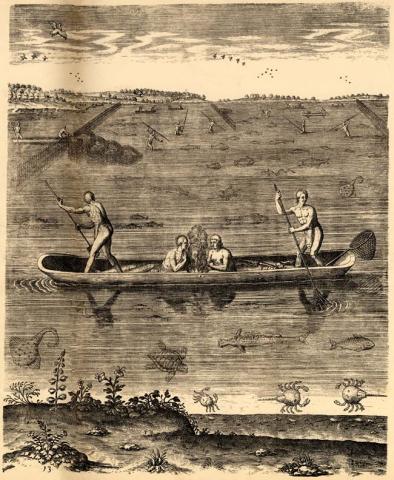
"Their Manner of Fishynge in Virginia." Theodor de Bry's engraving of American Indians fishing, published in Thomas Hariot's 1588 book A Briefe and True Report of the New Found Land of Virginia. In the foreground, four Indians are in a canoe in the water: The two on the ends stand holding oars or nets in the water. The two in the middle are sitting. Various animals are visible in the water, including fish, crabs, and a turtle. In the background, numerous other Indians are fishing. Some stand in the water with harpoon-like tools, and others are in canoes. A few are fishing at weirs, traditional American Indian fishing devices consisting of a fence-like trap made of sticks or reeds. The text accompanying the image reads: They have likewise a notable way to catch fish in their Rivers, for whereas they lack both iron, and steel, they fasten unto their Reeds or long Rods, the hollow tail of a certain fish like to a sea crab instead of a point, where with by night or day they strike fish, and take them up into their boats. They also know how to use the prickles, and pricks of other fish. They also make wares, with setting up reeds or twigs in the water, which they so plant one within another, that they grow still narrower, and narrower, as appears by this figure. There was never seen among us so cunning a way to take fish withal, whereof sundry sorts as they found in their Rivers unlike unto ours, which are also of a very good taste. Doubtless it is a pleasant sight to see the people, sometimes wading, and going sometimes sailing in those Rivers, which are shallow and not deep, free from all care of heaping up Riches for their posterity, content with their state, and living friendly together of those things which god of his bounty has given unto them, yet without giving him any thanks according to his desert. So savage is this people, and deprived of the true knowledge of God. For they have none other than is mentioned before in this work .
Public Domain
